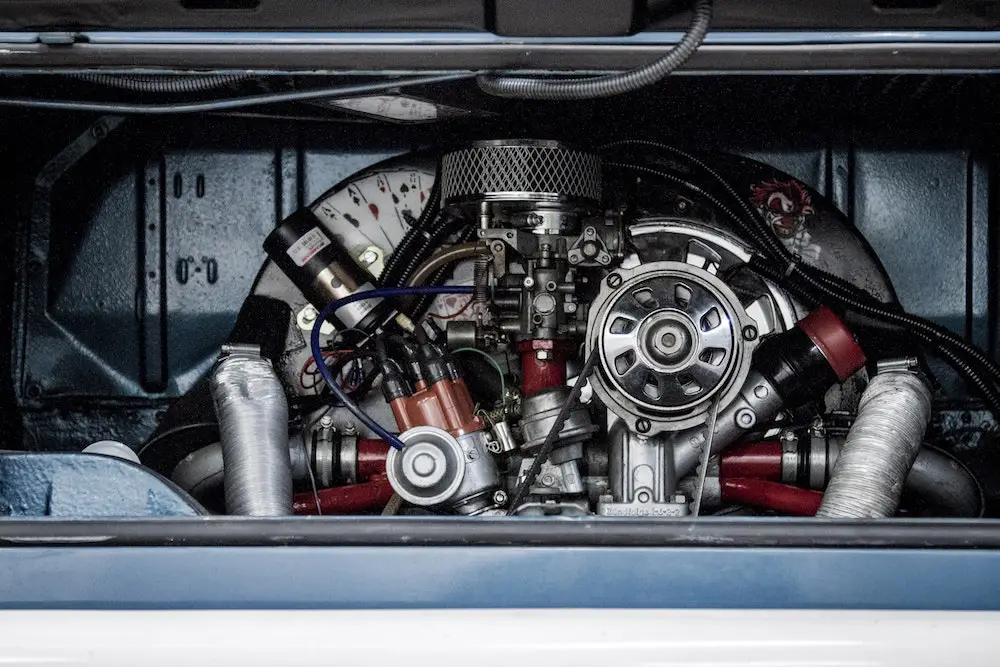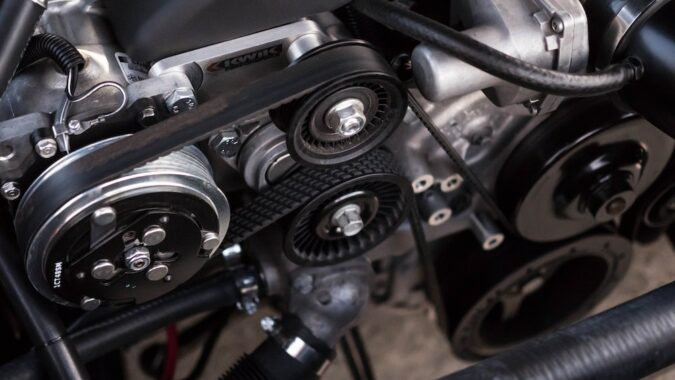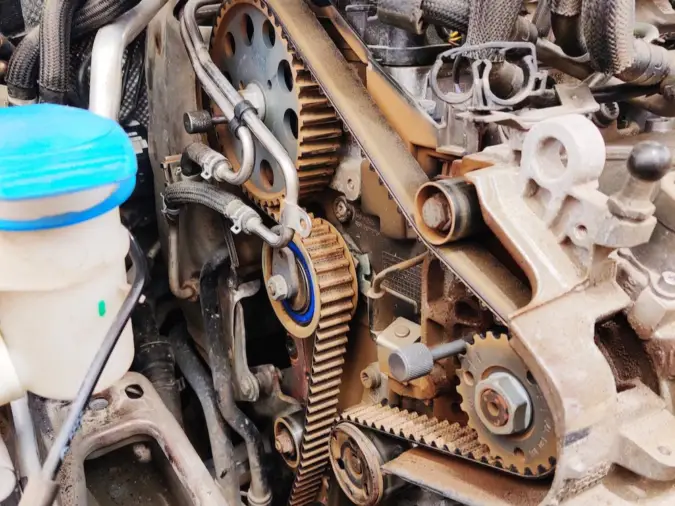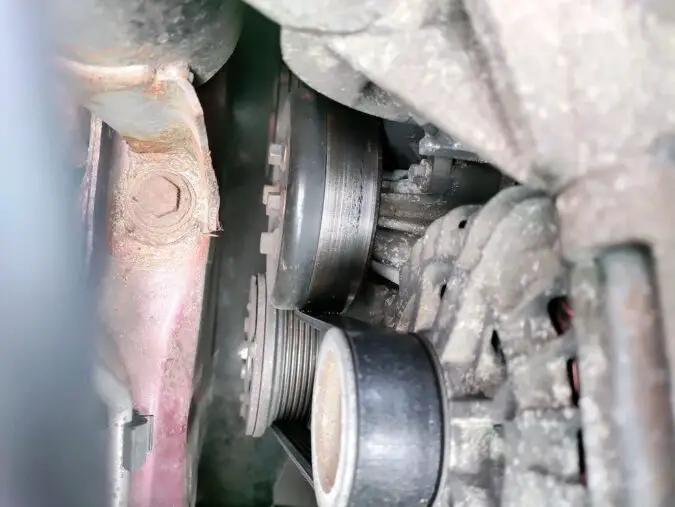Sure, the timing belt may appear to be a seemingly simple slice of rubber in your engine. But given its importance – and it’s indeed an incredibly vital componentry – one shouldn’t mess about with it. Hence, why we don’t condone the thinking of stretching past (pun intended) its usable lifespan. So, are there valid points behind the question, “can a timing belt last 200 000 miles or more?”
Well, we car enthusiasts do like to celebrate high-mileage heroes. Some examples include those cars that have accompanied their humans for hundreds of thousands – or millions – of miles.
So, this is actually a good question… Is this rubber belt really that durable? The short answer to ‘can a timing belt last 200 000 miles’ is, unfortunately, a solid “not really”. So, let’s clear up to you why…
- What Is A Timing Belt?
- Timing Belt vs Timing Chain
- Bad Timing Belt Symptoms
- When To Replace Them?
- Replacement Costs
- Can You DIY A Replacement?
- Final Conclusion
- FAQs
Timing Belt
Before we explain why you shouldn’t test the theory of can a timing belt last 200 000 miles, perhaps we should dive into what it does. So, what exactly is a timing belt? Well, it’s worth understanding that there are two principal elements of how an internal combustion engine works. Namely, these units in your engine are the ‘camshaft’, and the ‘crankshaft’.
Here’s a refresher on what they each do…
- Camshaft – Sitting at the top of your engine, this lobed shaft is connected to the valvetrain of your engine’s combustion chamber. Its job, done through a rotation of the shaft, is to open and close the intake and exhaust valves at precisely the right time. This ‘valve timing‘ ensures that air can enter your engine to be ignited with fuel, and its gases are exhausted sufficiently.
- Crankshaft – Meanwhile, your crankshaft is placed at the bottom of your engine. Connected to the pistons, the crankshaft simultaneously plays two key roles. Firstly, it synchronizes its movement with the camshaft to rotate the pistons up and down. In doing so, it could also take in the reciprocation motion of the pistons, and translate it into rotational energy that could be used to power the car.
In our explainer there, we exposed two hints – valve timing, and synchronization. The camshaft and the crankshaft respectively need to work together to maintain the valve timing.
For instance, if your crankshaft needs to move the pistons upwards when the camshaft closes the valves. This allows for the air to be compressed with the fuel, and thus ignited. Then, these two shafts continue spinning.
What Does A Timing Belt Do
But how can the camshaft and crankshaft – both being placed on opposing ends of the engine – be able to move synchronously? This is where your timing belt comes along, or sometimes referred to as the ‘timing chain’ or ‘cambelt’.
Both the camshaft and the crankshaft have pulleys, often located by the front of the engine. These pulleys are then joined together by the toothed timing belt. This way, the timing belt can precisely rotate both the camshaft and crankshaft proportionally.
But what if the timing belt fails, or if there wasn’t a timing belt there at all? In this scenario, the valve timing would be thrown out of whack. The engine won’t just perform poorly, but may even damage the engine itself. Imagine if the movement of the pistons and valvetrain are opposed to each other.
Modern engines have what’s called an ‘interference head‘ design. This means that the pistons and valves could make contact. If the timing is off, the piston would strike the valvetrain at speed, thus causing catastrophic damage. At this point, poor performance or misfires would be the least of your concerns. Instead, you’ll be left with thousands of dollars worth of bent valves, broken pistons, etc.
Timing Belt vs Timing Chain
In all, the functions of the timing belt are quite simple to contemplate. It works simply to time the rotation of the camshaft and crankshaft with perfect harmonization. Failure in doing so can cause the engine to break itself. Sometimes, it’s not worth saving, even. However, there’s another point we’d like to clear up, in that not all timing belts are the same. Nowadays, there’s a new contender.
A timing belt, although we quipped about it being a rubber belt earlier, isn’t actually made entirely out of rubber. It’s a reinforced rubberized material that contains composites such as nitrile.
Now, we all know what happens to anything that shares rubber’s structural integrity when exposed to heat, right? Over time, rubber can dry out, harden, crack, and sometimes snap under pressure.
Timing belts are, at least, rather quiet, and cheap to replace when they do need a service. But what if you want maximal rigidity? If that’s what you’re looking for, your car may have a ‘timing chain’.
Unlike a timing belt, which is often placed outside the engine, the timing belt can be housed within the engine itself. Made of metal, the timing chain receives lubrication from your car’s motor oil.
Compared to rubberized belts, the metallic timing chain lasts significantly longer. Plus, it could take in a lot more strain over time and is more resistant to wear and tear.
Recently, plenty of carmakers are installing timing chains instead of belts. While pricier, they’ve since evolved their design to make timing chains quieter and emit fewer vibrations. But for now, let’s stick to the belts.
Bad Timing Belt Symptoms
So far, hopefully, you’ve grasped why we warned you earlier not to test out can a timing belt last 200 000 miles. Even if the timing belt loses a few teeth, it can cause the timing of the camshaft and the crankshaft to be unbalanced and conflicting.
So, imagine then if the belt snaps off completely! The amount of damage done to your engine would be heart-breaking… And expensive to fix. In that case, how could we tell when the timing belt is about to go?
Well, the best thing you can do is to refer back to the owner’s manual and see how long the belt could hold out before requiring a timely replacement. Although, if you’re regularly sending your car for its routine service, you may not need to worry too much about it. Otherwise, there are a few symptoms of a faulty timing belt.
Should you notice any of these, it’s wise to stop your car, and call in a tow truck. Running the engine for much longer would be an expensive mistake. Even if you have a non-interference engine – where the pistons can’t collide against the valvetrain – you should still be diligent about replacing a worn-out belt. So, how can you tell if your timing belt needs to be swapped out?
Here are some handy tell-tale signs…
Can A Timing Belt Last 200 000 Miles, Symptoms #1: Engine Misfire
This is a classic symptom of a faulty timing belt. Usually, it means that the timing belt has slipped off the geared pulleys, and has fallen into the camshaft. When this happens, one of your engine’s cylinders might open and close too early, or too late. Remember, the cylinders need the right mix of air and fuel in volume to ignite.
If the cylinders open and close too early, there might not have been enough air or fuel in the right ratio. Your engine might be running “lean”, where there’s not enough gasoline to burn. Or, it might run “rich”, where there’s too much fuel, and not enough air to burn it with. In either situation, your engine’s cylinders – one or more cylinders – would misfire.
Can A Timing Belt Last 200 000 Miles, Symptoms #2: Rough Idle Or Stalling
You can still feel when your timing belt may be on its way out, even if the engine is just idling along. Should your timing belt not have been replaced in a while, the teeth that grip onto the camshaft and crankshaft gears will wear out. They become brittle with age, and could slowly break away one by one. The belt might still be fine, but the teeth would fall off.
When it happens, there’s a chance the timing belt’s teeth may fall into the gears or pulleys of the camshaft and crankshaft. Getting jammed in there could prevent your car’s engine from running smoothly. This is what causes the engine’s idle to be rough and unrefined. The poor timing may also result in the engine stalling while you’re driving.
Can A Timing Belt Last 200 000 Miles, Symptoms #3: Exhaust Or Engine Smoke
In colder climates, it’s normal to see a bit of steam or vapor coming from the exhaust. However, if there’s a bit too much smoke, the timing belt may be at fault (among other potential causes).
Once more, let’s remind ourselves that the timing belt helps to control the movement of the valvetrain. In other words, these control when to intake fresh air, and exhaust gases out of the engine.
Should the timing belt break or has worn down, the valvetrain would no longer move in synchrony. As a result, the exhaust gases would exit at the wrong times, which is why you’re seeing a lot more smoke than usual. Other than that, your engine might produce a bit of smoke as well. Again, this is another side-effect of not timing the intake and exhaust correctly.
Can A Timing Belt Last 200 000 Miles, Symptoms #4: Decreased Oil Pressure
So far, the past three symptoms aren’t technically too bad. If you notice them early on, there’s still time to get your timing belt replaced and consider replacing the timing belt, without any serious engine damage. Nevertheless, it can only get worse from here. One of the more worrying signs of a faulty timing belt is a reduction in your car’s motor oil pressure.
When the timing belt does go south, the uneven valve timing is strong enough to break off bits of the camshaft. These fragments would inevitably fall into the oil pan, and clog up the circulation of the oil.
This would be the reason why your oil pressure is running low, as it can’t flow across the engine. When this happens, the only possible fix is to rebuild or replace the whole engine.
Can A Timing Belt Last 200 000 Miles, Symptoms #5: Broken Valves Or Pistons
This is no doubt the worst symptom of a failed timing belt that you could ever experience. When the belt fails, it doesn’t mean that the camshaft and crankshaft will stop moving.
Instead, they’ll keep on turning, and potentially collide with one another with full force. With most car engines, there’s nothing in the way of stopping the crankshaft from turning, thus hitting the opened valves.
In turn, this will damage both the pistons and valves in the process. You might be able to notice that for a split second when you hear an apocalyptically destructive noise. Your car would lose power, too.
But unless you’re quick enough to shut off the engine to prevent the pistons and valves from colliding, it may already be too late. Only a full engine rebuild or replacement will do.
When To Replace The Timing Belt
In all, having your timing belt wear down or snap isn’t a good thing. That valve timing is very crucial to get right, or else. That said… When should you replace the timing belt? Can a timing belt last 200 000 miles?
Alas, this isn’t the case. To get a more precise estimate of how long your timing belt is actually designed to live, you should refer to your car’s owner’s manual. Otherwise, determining the well-being of the timing belt is surprisingly difficult in some cars.
It can be located underneath a timing cover, so a visual inspection won’t suffice in many cases. Hence, it’s hard to tell when the timing belt is ready to go bye-bye. This is why paying attention to the mileage is often the only decider of when you should be replacing your timing belt.
With earlier timing belt designs, experts recommend swapping them every 60,000 or 75,000 miles. For many of the newer automobiles and timing belts out there, the intervals are thankfully longer.
Some manufacturers recommend a timing belt replacement every 90,000 or 100,000 miles. Or, that’s roughly every 7 to 10 years, if we’re not counting by the miles. This is a good time span to swap out for a fresh timing belt before anything goes wrong. But can a timing belt last 200 000 miles, even in theory?
As we mentioned, the side effects are far too serious to test this out on your car by yourself. We’ve read in some forums of bold owners driving on timing belts that have gone through 150,000 miles or thereabouts. But none dare to go any farther.
Timing Belt Replacement Cost
For most of us, we shouldn’t really be living on the edge, and stretch the threshold of can a timing belt last 200 000 miles or more. Besides, the low end of 60,000 miles or 5 years is still plenty of time before you need to think about swapping it. After all, replacing the timing belt isn’t exactly cheap, per se.
So, how much goes it cost to replace the timing belt? It’ll vary widely on the make and model of your car, as well as the type of vehicle you drive. For smaller and more economical cars, you won’t need a heavy-duty timing belt.
Thus, a complete swap will set you back around $300 to $500. Meanwhile, an SUV, minivan, pickup truck, or sports car would need more performant and robust timing belts. These would cost you at least $700 on average.
At the higher end of the spectrum, luxurious automobiles may cost you upwards of $1,000 for a new timing belt (make sure you’re wary of when to change the timing belt). If your car uses a timing chain instead of a belt, that’ll be priced at a premium, as well.
Now, a lot of this cost comes down to labor rates. So, it’s worthwhile to understand how much the local workshop or dealer is going to charge you hourly for swapping out the belt.
Most timing belts can be found for as little as $25 to $50 dotted on the shelves of auto parts stores. Nevertheless, the labor rates as a whole will leave your wallet lighter by $200 to $900.
That’s because the timing belt can be a bit of a hassle to replace, taking a professional a few hours. Therefore, you should assess how easy or difficult it is to access your car’s timing belt.
How Much Do Timing Belts Cost
While it’s already expensive enough to get the timing belt replaced, there are some other thoughts and considerations to make. Since you’re already spending lavishly on labor rates for the mechanic to swap out the timing belt, you may as well cash out a bit more, right?
Experts do recommend that when you’re having a new timing belt installed, its surrounding components could do with a service. These parts will be easier to get at once the timing belt is off.
So, if their time is due, or when they’re also showing signs of wear, getting them replaced isn’t a bad idea. This way, you can avoid having to make another stop at a workshop in the future. So, what are these auxiliary components?
1. Water Pump
Its job is to circulate coolant around to keep your engine cooled. In many cars, the water pump is driven by the timing belt. Often, the pump needs to be removed when you’re swapping out the timing belt. This complexity is why you ought to replace the pump too if it’s showing signs of wear. A new pump could cost you up to $800, thanks in no small part to labor rates.
2. Pulleys And Tensioners
There will be a few of these, as they work to keep the timing belt taut and rotation without any slack. Additionally, these pulleys and tensioners keep the timing belt in place. If they fail, even a brand-spanking-new timing belt would break prematurely. Either by falling out or running loose, the same engine damage could still occur.
3. Front Engine Seals
It’s also referred to as the crankshaft seal, placed at the front of the engine. This is one of many seals around the engine’s front end, which is easily accessible once the timing cover is off. It keeps the motor oil in check and prevents leaks. By replacing the seals – which are relatively cheap in raw materials – you can ensure that your engine will run reliably and smoothly.
Can I Replace Timing Belt Myself
Plenty of folks have considered swapping out the timing belt on their own, thus getting past the oft-expensive labor rates. But is this a good idea? Personally, we’d list a timing belt replacement as one of the most complex fixes to do, especially DIY-style.
It should only really be done by those who have ample technical experience with cars. Plus, you’ll need a significant quantity of tools, as well. There are a lot of parts that you need to detach before getting to the timing belt. You have to remove certain other belts, such as the fan belt and the power steering belt.
Then, the timing cover and the aforementioned water pump need to be removed before getting to the timing belt. Once that’s all said and done, you have to properly mark down and realign the new belt on the gears as is.
Otherwise, the valve timing between the camshaft and crankshaft will be thrown out of balance. To put it another way, swapping the timing belt would’ve only made things worse if this is so.
As such, we don’t recommend this job for those of us who don’t have the know-how or tooling. You’re better off spending the extra on getting a professional mechanic to do it properly.
Can A Timing Belt Last 200 000 Miles: In Conclusion…
So then, that summarises our look at what the timing belt is, how it works, and why it’s important. Can a timing belt last 200 000 miles or more? No, it can’t. And frankly, you really shouldn’t test this out in person, unless you have a jalopy that you won’t mind sacrificing. If you keep your car running with a worn-out, poorly, or faulty timing belt, then expect catastrophic engine damage.
It’s by no means an affordable investment to get your timing belt replaced. It’ll cost you hundreds, or in some situations nearly or more than $1,000. However, this pales in comparison to the $2,000, $3,000, or often higher to rebuild a failed engine as a consequence of a damaged timing belt. Who knew this sliver of rubber could cause you this much heartache when it fails, eh?
FAQs On Can A Timing Belt Last 200,000 Miles
If you’re still curious to learn more about can a timing belt last 200,000 miles, our FAQs here might help…
What Is A Timing Belt
A timing belt (which is also sometimes referred to as a cambelt), is a literal belt that runs along the front of the engine. Its functions are to synchronize the timing of the engine’s camshaft and crankshaft and their respective rotations. For example, when the crankshaft is pushing the pistons upward, the camshaft needs to close the intake valves. That would thus allow air and fuel to be compressed inside the now-sealed combustion chamber, before being ignited. Once that cycle’s over, the force will push the piston back down, rotating the crankshaft, as the camshafts will now have to open the valves to allow fuel and air to enter. This synchronized motion is thanks to the timing belt.
How Much Does It Cost To Replace A Timing Belt
For a timing belt replacement, the belts themselves can be found for cheap on most auto parts store shelves. In many cases, timing belts go for as little as $25 to $50. Still, the amount of labor required to access and replace the timing belt, as well as re-calibrate the valve timing means that your mechanic will have to charge more. On average, the mechanic might charge you between $200 or as high as $900 in labor alone. Combined, a timing belt replacement averages around $300 to $500 for most cars. Depending on your car, certain vehicles might have timing belts that are harder for the mechanic to access, which can easily drive up the cost to as high as or even beyond $1,000.
What Happens When Timing Belt Breaks
One of the worst things that could happen to your car is having the timing belts break. This can happen very suddenly and often without any warning if you’ve been missing out on a regular service or timing belt replacement. When the timing belts break while you’re driving, the camshaft and crankshaft will no longer be synchronized. Now moving separately, the crankshaft will continue to spin rapidly. Yet, the camshaft is fully stopped or is slowing down. All the while, the crankshaft will continue to force the pistons to rise or fall in quick succession. In many instances, they will strike the intake and exhaust valves with such high impact, that it’ll cause irreparable and costly internal damage.
How Long Does Timing Belt Last
A timing belt is typically made out of rubber, though some are manufactured out of polyurethane or neoprene. Meanwhile, its inner structure is then reinforced with fibers, and you’ll even find robust fabric covers on the toothed surface of the belt. Given the fact that a timing belt is mostly made out of reinforced rubber, the excessive heat from an engine will, over time, cause that rubber to harden and crack. In other words, a timing belt is not made to last forever. In general, a timing belt is usually good for between 40,000 to 100,000 miles before it needs a replacement. Meanwhile, a timing chain (often made of metal) lasts longer, often between 80,000 to 120,000 miles.
How To Check Timing Belt
Given its importance in the smooth and reliable running of your engine, it’s worth taking a look at the timing belt every now and then. Even a simple visual analysis should be enough to give you ample clues on whether you need to replace it anytime soon. Start off by looking at the surface of the timing belt. Then, check to make sure that there are no oil, grease, grime, or other contaminants that could eat away at the rubber. Also, ensure that there aren’t any cracks on the belt itself. Once you’re done doing that, look at the underside of the belt, and inspect the timing belt’s teeth. See if any of the geared teeth are missing or have been damaged in any way.






1 comment
On and on and on you go extolling the necessity of spending lots of money to change out timing belts before they disintegrate and destroy your engine. Why, why, why don’t you lousy money grubbing mechanics help us out and mount a campaign to outlaw the damn things? Timing chains last forever or nearly so. Quit helping planned obsolescence!